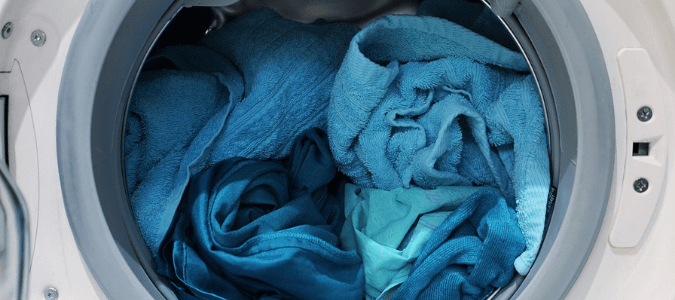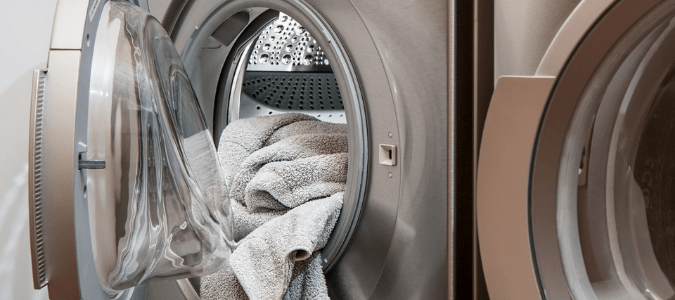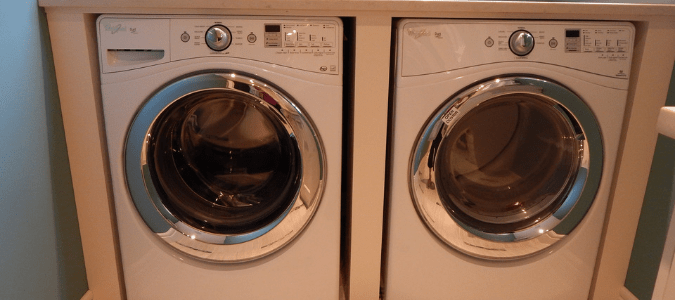
It’s frustrating to put a load of laundry in the washer and press start, only to wind up a half-hour later with a machine full of wet clothes and dirty water that won’t drain. When this happens, it’s most likely because your washing machine drain has a blockage that needs to be cleared before the water can properly exit the machine. The most common reason for a clogged drain from washing machine is an issue with the filter.
Appliance repair specialists find all sorts of items—most commonly, socks, underwear and baby clothes—that have gotten stuck in washing machine filters during the wash or spin cycle. This happens because it’s easy for small items to slip through, block the filter and prevent the washer from draining properly. If your washer isn’t a front-load type of washing machine, however, the problem is likely due to something else, as only front-loading machines are equipped with filters.
Another common reason for blocked drains in washing machines is when the drain pump fails. This can happen on either front load machines or traditional top load machines, and it is almost always a mechanical problem—meaning a physical part that breaks and needs to be repaired. This happens most often in older washing machines, as it becomes more likely as the washer and all of its working parts age. In many cases, it’s worth repairing the broken drain pump rather than replacing it altogether.
Many newer washing machines will display error codes that can reveal the exact issue that has occurred when there’s a problem, whether it’s the drain pump or something else. Even if your washer doesn’t show error codes, it’s always wise to check your machine’s manual when something goes wrong, in case it’s an easy fix or reset that you can handle on your own.
Furthermore, as with many things in life, a few, simple preventative measures can go a long way toward keeping your washing machine in good working order and free of clogs in the drain. The first step that anyone can take is placing smaller items like socks, undergarments or baby clothes in a mesh bag to wash, so they can get clean without getting lost in the inner parts of the machine.
If you have a front load washing machine, it’s also a good idea to clean its filter regularly. The filters on most washing machines of this type are located on the front, left-hand corner of the machine. You can check your particular model’s manual, but for most front load machines, you simply open the panel (you may need a flat-head screwdriver to pop it open) and unscrew the filter, or the circular cap covering the filter, by hand. Pull the filter out, remove any lint or other items you find, and replace the filter. That’s it—you’re done!
If your washer still has standing water inside it after clearing the filter, you may also need to empty the drain hose that is located next to the filter. If this is the case, no special tools are needed, but do have a bucket or a pot ready, so the water won’t go all over the floor. If the drain line won’t empty on its own, there may be a clog in the rubber tubing itself that needs to be cleared. This is something you’ll want to hire an appliance repair specialist to handle, as you’ll want to make sure this is done correctly to resolve the blockage and ensure you don’t accidentally do any damage to any of your washer’s parts.
Clearing the filter on a front load washing machine is one of the easiest things that almost any homeowner can do to keep their washer running smoothly, and emptying the standing water through the drain line can be simple, if there’s no blockage in the tubing. Other maintenance and repair issues, unfortunately, may not be as simple to address. Top-loading washing machines are equipped with lid switches that sometimes fail. If this happens, closing the lid won’t trigger the machine to move through its wash, rinse and spin cycles. Another possibility is a problem with the drive belt. Sometimes, these can become loose or break altogether, causing the same symptoms.
If the problem with your washer is a broken drain pump, lid switch or drive belt, it’s a good idea to enlist the services of an appliance repair specialist who can repair your washer quickly and correctly, or else recommend replacing it altogether if fixing the problem will cost more than getting a new washer. If you do find yourself in that position, you’ll have both peace of mind and a working washing machine that you can rely on.
Although we typically don’t think twice when throwing a load of laundry into the wash, there are a variety of problems that can present themselves when doing this routine chore. In addition to having a clogged washing machine drain, two other common washing machine problems are finding that your clothes have a foul smell and having a leak coming from your unit. Keep reading to learn what you can do to address these issues and when to contact a pro.

Why Does My Washer Smell Like the Sewer?
There’s nothing worse than running a load of laundry, expecting to have clean clothes at the end, only to find that your washer smells like sewer water and your clothing is far from clean. Unfortunately, since clothes washing machines are appliances that are frequently wet, closed and also full of dirt and grime, they are prime breeding grounds for mildew, mold and other potentially smelly situations. In most cases, it’s likely that the sewage smell is coming from a buildup in the washer of wet, gunky lint in the washer’s filter. Sometimes, however, the smell is coming from something more dangerous that needs to be addressed as soon as possible to avoid bigger problems.
If you have a front-load washer that smells like sewage, a simple first thing to check is the filter, which is most likely located in the lower-left-hand corner of the front of the washer. As we have already mentioned, on most front-load models, the filter is behind a panel that will need to be popped open for access. You may need a flat-head screwdriver for this. Next, unscrew and pull out the filter to check for lint buildup. If there is any lint (or anything else) present, simply remove it and throw it away.
If the filter is the source of the problem, the washer could still smell dank even after you’ve cleaned the filter unless you run a cup of vinegar through the wash. Sometimes moldy smells also come from the rubber door gaskets on front-load machines. Vinegar can help with this problem as well. Wipe these gaskets down on a monthly basis with a mixture of vinegar and water, and replace the gaskets if the bad smell starts to permeate to your clean clothes after a wash. It’s also a good idea to leave the washer door open between uses to reduce the chances of mold or mildew growing inside.
Laundry detergent buildup can also contribute to bad smells coming from your washing machine. Sometimes, simply switching to high-efficiency laundry soap solves the problem. Other simple washing machine appliance tips include cleaning your washer monthly, including its filter and rubber gaskets. Doing this task regularly can also help lengthen the lifespan of your washing machine.
If your washer smells like sewage whenever you use it, this could indicate a dirty, clogged drain in need of cleaning or possibly some other problem. Contacting a licensed, reputable plumber is the fastest and most effective way to address this type of problem, since plumbing specialists are experienced in cleaning and inspecting all parts of a washing machine, including its hoses, filters, pumps and drain lines and are able to troubleshoot almost any type of issue. When you contact a licensed plumber, you don’t have to worry about any common plumbing mistakes and you can be confident the job will be done quickly and correctly.

Drain Hose Washing Machine Leaking: What To Do
It’s generally easy to tell when the drain hose in your washing machine is leaking, because water leaks out and gets all over the floor when you use your washer. There are several possible reasons why this might be happening, and they range from a relatively easy fix to more technical and complicated repairs or replacements.
The simplest reason why the drain hose might leak is that it’s not positioned correctly at the point where it hooks into the opening in the wall behind your washing machine. Drain hoses sometimes get knocked out of place if you’ve recently moved the washer or made other adjustments in the area of the drain hose. If this is the case, simply resettle it into the opening in the wall to make sure it’s positioned right and able to drain water properly.
Other common drain hose problems that can cause a leaking washing machine include water supply hoses that have gone bad, or the gaskets just inside the mouth of these supply hoses needing to be replaced. An appliance repair specialist will start making this repair by turning off the water supply. Then, either by hand or using a wrench, hoses can be disconnected. Next, using a flat-head screwdriver, the old gaskets can be popped out and replace them with new ones.
A blockage in your home’s drain line is another common plumbing problem that can cause washing machine leaks. A good plumber can address the issue by cleaning out the drain line and inspecting all the other parts of your washer to ensure everything is in working order. There are other possible causes of washing machine leaks as well, such as a faulty drain pump or internal hoses, or worn-out tub fittings. Each of these issues is best handled by a specialist with the necessary expertise to diagnose the problem correctly and make all needed repairs to your appliance, so you can trust your washer will last for years to come. Your specialist can also give you tips on how to care for your washer and dryer.
ABC Can Get Your Washer Running and Keep Clothes Fresh
We rely heavily on our washing machines to get our clothes nice and clean. When something goes wrong, whether it be a clog, a bad smell or a leak, it can cause a huge disruption to your life. When you contact ABC Home & Commercial Services for appliance repair, we will send a specialist out to come make things right. Our professionals are licensed and highly-trained, so you can rely on them for a variety of services including repairs, installations and maintenance, as well as for overall advice on any appliance-related questions you may have.
